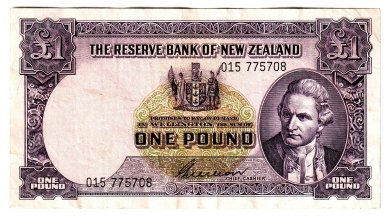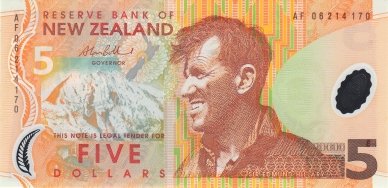The New Zealand Dollar
The NZ dollar (NZD, NZ$) is an internal means of payment of New Zealand and some other free association island countries like Niue and the Cook Islands. It is also circulated in the Pitcairn Islands (the British Overseas Territory) and Tokelau.
NZD is a freely converted currency with a free-floating exchange rate, actively used in carry-trade deals due to high yield.

History
New Zealand had not had its own currency till 1907. The NZD’s predecessors were the British pound and the Australian dollar. In 1907, when New Zealand became the British dominion, it gained its independence and obtained its national currency, the New Zealand pound.
It was similar to the British pound sterling and was subdivided into 20 shillings. Each shilling was equal to 12 pence. The New Zealand pound had been issued by private banks till 1930. Then the exclusive right was given to the Reserve Bank, which issued the first series of notes in 1934. The Treasury of New Zealand minted the coins till the end of the 1980s.

New Zealand pound banknote
The dollar replaced the NZ pound in 1967 when the New Zealand financial system switched to decimal currency. Since then, NZ$1 has been divided into 100c. The old notes were exchanged into the new ones with a ratio of 1:2.
A new currency was pegged to the USD with an exchange rate of 1:1.39. However, the crises in New Zealand and the USA changed that ratio very soon. The attempts to alter the currency exchange rate led to a new peg in 1973: NZD was directly dependent on the currency basket of the counties that New Zealand had the biggest trading volume with.
In 1985, the New Zealand dollar was marginally less valuable than the US dollar with a rate of 1:0.45. So a fluctuating exchange rate has been introduced.
Design
The banknotes of denominations of NZ$5, NZ$10, NZ$20, NZ$50, and NZ$100, and coins of 5c - 50c, NZ$1, and NZ$2 are in circulation on the territory of New Zealand and a range of other countries. Since 1999, banknotes have been produced from a special type of plastic. No other country in the world uses this material to produce money.
The obverse of dollars depicts the portraits of prominent people who had a marked impact on the country’s life. The reverse side shows pictures of New Zealand birds. This design has been highly evaluated in the world’s financial community, and the NZ dollar has taken the sixth position as the world’s most beautiful currency.

New Zealand $5 banknote
The design of the New Zealand dollar changed many times. The series of 1967, 1981-1983, 1990, 1992, and 1996 were printed on a special paper. The obverse sides usually had the portrait of Queen Elizabeth whereas the reverse depicted rare birds of New Zealand.
At present, New Zealand dollars have a similar but more colourful design:
- NZ$5 is an orange banknote that features the portrait of the explorer Sir Edmund Hillary and the hoiho penguin.
- NZ$10 is a blue banknote featuring the portrait of Kate Sheppard, a prominent writer and women’s rights activist, on the obverse and the whio duck on the reverse.
- NZ$20 is a green banknote that depicts the portrait of the British Queen and the New Zealand falcon.
- NZ$50 is a purple banknote with the portrait of the ethnographer Āpirana Ngata on the obverse and kōkako on the reverse.
- NZ$100 is a red banknote that shows the portrait of Ernest Rutherford, a physicist, Nobel laureate, and the author of the atomic nuclear model, on the obverse, and the mōhua bird on the reverse.

The New Zealand 2 dollars coin
Apart from an excellent design, the New Zealand dollar has multi-level security features. All banknotes have a shadow image of Queen Elizabeth II and a framed window with an embossed denomination. Besides, the image of denomination numbers changes if to look at a note at different angles.
The denominations can be also felt because the production of NZ dollar banknotes includes cameo printing.

New Zealand Currency in the World
This currency is widely used in Forex trading transactions. Moreover, it is considered one of the most profitable in the world because its exchange rate directly depends on the two most traded raw materials like oil and gold. Since New Zealand has the biggest turnover with Australia, there is also a significant influence of the Australian dollar.
